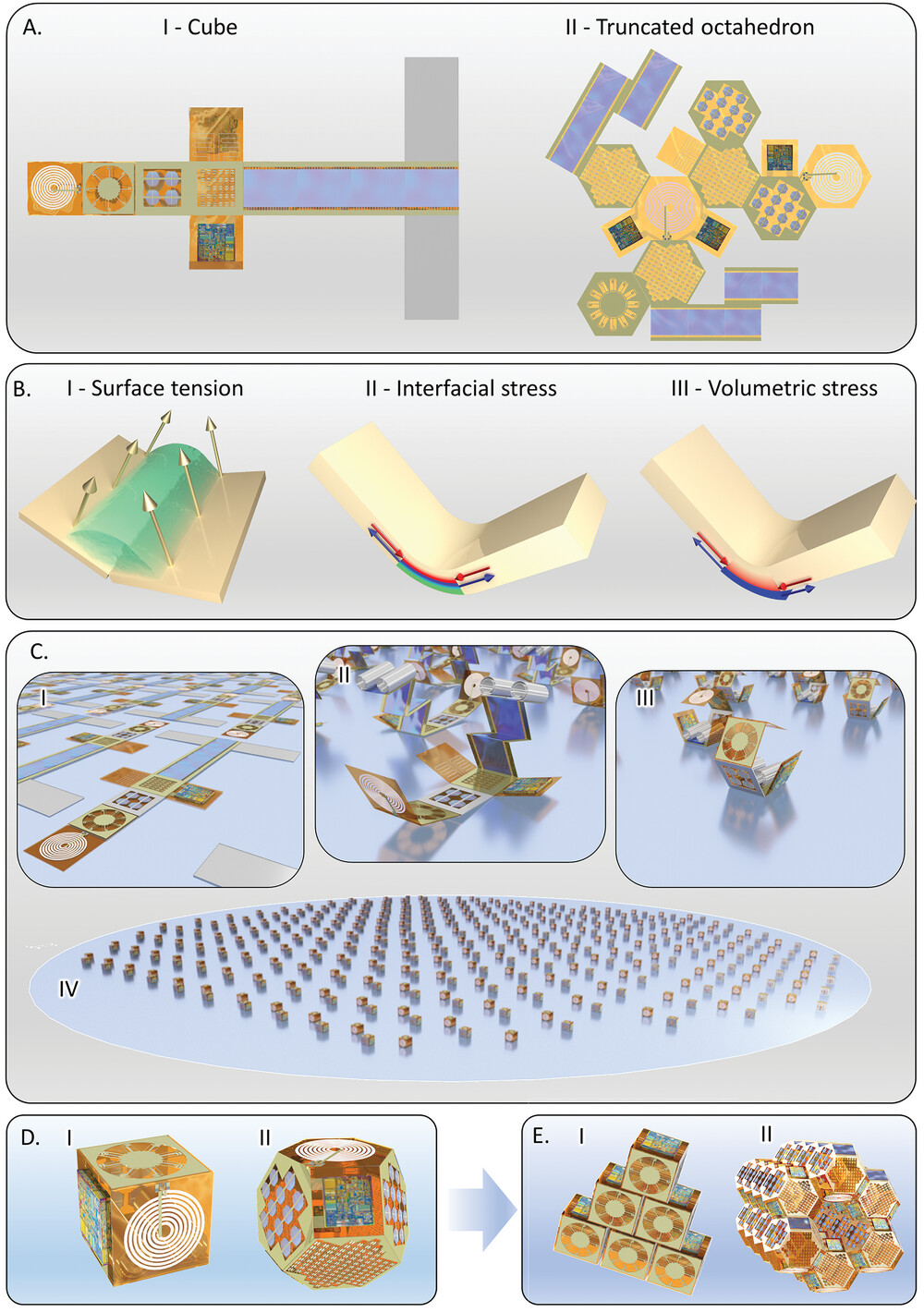| Nov 11, 2023 |
| |
|
(Nanowerk Spotlight) For decades, scientists have dreamed of creating synthetic lifeforms – robots and electronics that can self-assemble, self-repair, and exhibit lifelike behavior emergent from billions of microscopic interactions, much like natural organisms. This vision has fired imaginations in science fiction but remained stubbornly out of reach in reality. However, recent breakthroughs across several fields are bringing this grand challenge tantalizingly close.
|
|
The core inspiration lies in the remarkable properties of living cells, the basic building blocks of all known life. Individual cells can maintain stable internal conditions, contain a boundary between self and non-self, move, sense their environment, communicate with each other and even self-replicate. At a higher level, communities and lineages of specialized cells have evolved into the complex multicellular life around us, from bacteria to blue whales.
|
|
Mastering the nanoscale assembly of non-living structures to achieve these living properties has proven extremely difficult. But we are now witnessing several key developments in science and engineering that could make this possible. For example, advances in microfabrication allow intricate electronic circuits and sensors to be patterned on ultrathin films with features smaller than a micron. Meanwhile, novel nanomaterials like hydrogels and liquid metals can now change their shapes dynamically in response to electric signals.
|
|
Combining these shape-changing materials with flexible high-density electronics creates a new generation of microscopic modules that can reshape themselves on demand. With tiny onboard microprocessors, these “smart matter” modules can essentially become programmable folding robots of their own. They can be engineered to link up with neighboring modules in three dimensions, exchanging power and data, and even actively disassemble and reconnect to form entirely new emergent structures.
|
 |
| Example of currently fabricable SMARTLET with some key labeled functionalities. (Reprinted with permission from Wiley-VCH Verlag)
|
|
In a nutshell, we are beginning to have the raw ingredients for electronic and robotic systems that mimic how collections of living cells self-organize into viable, adaptable, evolving organisms. It is this convergence that now brings artificial living organisms tantalizingly close to reality. There remain enormous challenges ahead, but the most ambitious dreams of futurists now seem to be within the laws of physics, if not quite yet engineering.
|
|
In a new perspective article published in Advanced Materials (“Microelectronic Morphogenesis: Smart Materials with Electronics Assembling into Artificial Organisms”), researchers argue that we are on the cusp of a technology they call “microelectronic morphogenesis,” which allows electronic materials to actively reshape themselves into complex, life-like structures.
|
|
The authors, led by John S. McCaskill and Oliver G. Schmidt of Chemnitz University of Technology in Germany, say this could lead to “artificial organisms” made of electronic parts that exhibit some of the core properties of natural living cells, including the abilities to maintain homeostasis, contain a boundary between self and non-self, and reproduce/self-assemble.
|
|
While fully autonomous artificial organisms remain speculative at this point, the building blocks are coming together. The researchers point to recent breakthroughs in manufacturing ultra-thin flexible electronic materials that can reshape themselves in three dimensions in response to stimuli like heat or light. Using techniques like origami and kirigami (cutting and folding), researchers can pre-program flat materials to curl, bend, and fold in specific ways to form complex 3D modules.
|
|
These flexible electronic materials can host components like sensors, actuators, batteries, and crucially, tiny computer chips. The addition of microprocessors allows each module to contain digital information about how to reshape itself and interact with other modules. The researchers call these intelligent building blocks “SMARTLETS.”
|
 |
| Microelectronic pathway for morphogenesis. A) Designs of planar layouts that integrate a variety of electronic functions and can re-shape themselves into 3D structures: a cube and a truncated octahedron respectively. B) The fold-up self-assembly of these structures is driven by commonly used physical forces like I. surface tension, II. stress at the interface of thin-films or III. volumetric expansion of materials like hydrogels. C) Self-assembly occurs in parallel for all the planar structures fabricated on a wafer: I–III successive folding stages closeups, IV completed folding on wafer. D) Self-assembled architectures equipped with microelectronic functions form SMARTLETs (basic active building blocks). E) SMARTLETs can then be aggregated passively or actively into higher hierarchical assemblies: I—cubes; II—truncated octahedrons. (Reprinted with permission from Wiley-VCH Verlag)
|
|
Through precise physical encoding and complementary shapes, researchers can get SMARTLETS to self-assemble into hierarchical organisms with differentiated structures and functions, not unlike the cells that group together to form complex organisms in nature. And thanks to the onboard electronics, the overall structure can actively maintain and repair itself by triggering individual modules to disassemble and reconnect.
|
|
The potential parallel with biology goes even further. The information that controls an artificial organism’s morphology and functions can be encoded in a “genetic recipe” stored in the electronics of each SMARTLET. This recipe provides instructions for fabricating new SMARTLETS off-site to replace defective modules, allowing a form of self-reproduction.
|
|
While biological organisms carry this genetic recipe in DNA, the researchers argue that electronic information could play an analogous role in artificial systems. This would replicate a key innovation of natural life – the separation of replicable genetic information that encodes complex, non-replicable 3D structures like proteins and cells.
|
|
The researchers envision that we are only scratching the surface of what could be possible with programmable electronic materials and self-assembling intelligent modules. Potential applications range from minimally invasive medical devices that assemble inside the body to swarms of microscopic sensors or robots that build complex structures on demand.
|
|
[embedded content]
|
|
Assembly of architectures where multilayer pattern elements using microsystem technology fold up into 3D structures, self-assembling to form microelectronic SMARTLETs with self-propulsion. These SMARTLETs can then be aggregated passively or actively into higher hierarchical assemblies.
|
|
The technology still faces hurdles before fully autonomous electronic artificial organisms can be realized. For one, modules will need to become much smaller, closer to the scale of individual cells. The addition of electronic components also brings power requirements that nature doesn’t have to contend with. Nonetheless, integrating technologies like energy harvesting and wireless power transfer could help overcome these limitations.
|
|
While the notion of synthetic organisms may conjure images of self-replicating nanorobots run amok, the researchers point out that bio-inspired electronics could actually be safer and more controllable than natural life. The required fabrication techniques and specialized components means these systems couldn’t proliferate outside of controlled environments. And the inclusion of traceable electronic tags on each module provides a high degree of monitoring and accountability.
|
|
The researchers maintain that artificial organisms made of intelligent materials represent a grand challenge for science and engineering, allowing us to pursue a deeper understanding of life itself. And the highly programmable, sustainable and economical approach could also lead to transformative real-world technologies.
|
|
So, while electronic artificial life may still be on the horizon, thanks to recent materials advances, the horizon appears closer than ever before. The rise of microelectronic morphogenesis could mark a new phase in the quest to program intelligent behavior in physical form.
|

By
Michael
Berger
– Michael is author of three books by the Royal Society of Chemistry:
Nano-Society: Pushing the Boundaries of Technology,
Nanotechnology: The Future is Tiny, and
Nanoengineering: The Skills and Tools Making Technology Invisible
Copyright ©
Nanowerk LLC
|
|
|
- SEO Powered Content & PR Distribution. Get Amplified Today.
- PlatoData.Network Vertical Generative Ai. Empower Yourself. Access Here.
- PlatoAiStream. Web3 Intelligence. Knowledge Amplified. Access Here.
- PlatoESG. Carbon, CleanTech, Energy, Environment, Solar, Waste Management. Access Here.
- PlatoHealth. Biotech and Clinical Trials Intelligence. Access Here.
- Source: https://www.nanowerk.com/spotlight/spotid=64038.php






